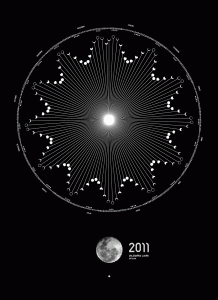Right now I’m sitting in the main ‘ballroom’* of the NASA Ames conference center. I’m here for the NASA Lunar Forums, which are hosted by the NASA Lunar Science Institute, which is housed at NASA Ames. (As one might guess, there are NASA meatballs everywhere). It is a good meeting, filled with good content, and all the latest good news from the Lunar Reconnaissance Orbiter. The multi-hat wearing Nancy Atkinson is here writing stories for Universe Today and recording podcasts for 365 days of Astronomy. I’ll leave it to her to talk science. While she’s busy doing the fun stuff, I’ve been in and out of meetings, and working to plan great (I hope!) things for the future.
Coming up on October 8, 2011 (and on TBD dates in future years) is the International Observe the Moon Night. This special event invites the world to look up and learn about the moon. This may seem like a “Yada yada yada, whatever…” kind of event, but it’s surprising how many new discoveries about the moon don’t make it into the heads of Joe six-pack and his kids. Since the 1990s, so many spacecraft have visited the moon from so many nations that I have given up keeping track of them! Yet, despite the wealth of new info, researcher Emily CoBabe-Ammann found that no available public school book contains lunar science results that come from modern exploration – everything is based on Apollo! Well, Apollo was before I was born and it’s time to change what people know about the moon.
I personally can’t change the US school system, but, with your help, I might be able to get some curiosity arousing materials into school teachers’ hands and onto cubical and household walls. Here is where you come in: Inspired by the amazing Lunar phase data visualization shown at right, we’ve decided at Astrosphere (parent non-profit of Astronomy Cast, 365 Days of Astronomy, and several other projects) that we are going to hold a lunar phase visualization contest. (And if Dimitri opted to enter, I’d love to see what he does with 2012!)
Your challenge, should you choose to accept it, is to create a calendar for 2012 that communicates the phases of the moon in a way that is interesting, beautiful, and true. Our intention is that we will print the winning poster for distribution. (We are assuming we’ll get awesome submissions, but failing that, we reserve the right to only post the winning entry online.) on the back of each material will be a fact sheet on the moon that uses modern data and images.
Complete contest rules and guidelines here: Visualize-the-Moon Poster Contest
Now, we know some of you aren’t exactly artistic, but may want to help support getting awesomeness into the hands of teacher. That’s cool, there are ways for you to help to! 1. The big thing you can do today is help get the word out. Let people know via twitter, Facebook, your blog, you sig, write it on your classroom chalkboard, and, heck, write it on your forehead (ok, maybe not that). Whatever you do, anything you can do to help get the creative people in your life engaged would be awesome. 2. Donate to Astrosphere to help pay for teaching materials to get mailed to teaches. 100% of proceeds will go to printing, postage, and admittedly paying the poor person who will stuff the audience (but he works quickly and effectively). Using your funding we will send teaches requested posters and other educational materials from Astrogear.org. And finally, 3. Start thinking about planning or attend an Intenational Observe the Moon Night event on October 8.
So… Get engaged in the moon.
This donation link is specifically to donate to buy materials for teachers:
*For reasons I’ll never understand, in conference center speak, ballrooms are the large rooms that can contain the most chairs. While there may very occasionally be an actually ball in said ballrooms, their primary function is numbing butts while brains get filled.




I’m really confused about that poster. It seems to be saying that the Moon is closer to the Sun when the Moon is full. That’s not right!
Could you provide us with a link to various sizes of the Astrosphere New Media logo? It’ll come in handy. Bigger is better, with transparency if possible…
Great information 🙂